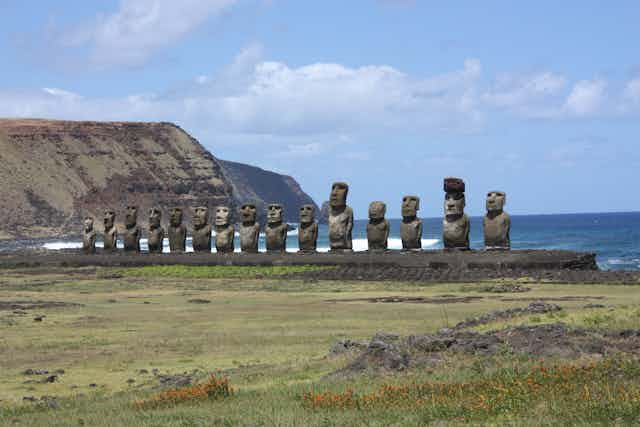Ask the average person what they know about Easter Island and those monumental statues with their inscrutable expressions would likely top the list. For many this is the sum total of their knowledge, for the excellent reason that Easter Island is a very small and exceptionally remote spec in the eastern Pacific.
Administered by Chile 3,600km to the east, and some 2,000km from its nearest inhabited neighbour, Pitcairn Island (a UK overseas territory), Easter Island is in fact one of the remotest inhabited places on Earth.
Apart from statues and inaccessibility, the other notable thing about Easter Island is the ecological disaster that led society there to collapse into warfare and starvation several centuries ago. We still don’t know exactly what happened, but the classic and still convincing story says that Easter Islanders chopped down all their trees to erect statues. The result was soil erosion, loss of fertility and the collapse of food production. And with no trees to make boats, fish were hard to catch on the rugged wave-tossed, cliff-lined coasts and the people became cut off from the rest of the Pacific.
For a place surrounded by trackless seas, Easter Island’s stories have remained resolutely land-bound. But that may soon change. Plans are afoot to turn a vast area of neighbouring ocean into a marine protected area. An announcement from Chile’s president, Michelle Bachelet, is expected on October 5.
Conservationists who have spent years campaigning for protection, like the Pew Environment Group’s Global Ocean Legacy program, hope the protected area will be very large, and enforced by Chile’s navy. If current plans are realised, Easter Island will become one of the biggest marine protected areas in the world with industrial fishing by non-islanders banned for 200 miles in all directions.
Locals still haul their lines in by hand which limits their catch. Their fishing association supports the marine park as it will give them some protection from illegal competition – islanders will still be able to fish up to 50 miles offshore.

But what is special about these seas? It is that isolation again. The island’s remote setting has so far spared its seas from the worst depredations of the world’s distant water fishing fleets. In places that are easier to reach, populations of big fish such as tuna, swordfish and sharks have been driven down by intensive industrial long-lining and purse-seine nets. Long-lines may be tens of kilometres long and can carry tens of thousands of hooks, while purse seine nets are used to surround whole schools of fish and anything else that happens to be with them, such as turtles and dolphins. Such fishing has led to losses of 90% or more in vulnerable species like oceanic whitetip sharks or leatherback turtles.
Isolation also means that Easter Island, although not as rich in species as places further west in the Pacific, has a bevy of sea creatures found nowhere else in the world including colourful dwarf angelfish, hermit crabs, tiny starfish and a slipper lobster. It’s a tightly connected web – some of these endemic species feed mainly on other endemic species. If they disappear from here, they disappear everywhere, so safeguarding them is a priority.

If Easter Island’s waters receive the protection they deserve, this place will join a growing number of very large marine protected areas being set up today. There is a long overdue wave of conservation action going on in the sea that has parallels with pioneering efforts to create the national parks of North America and Africa in the late 19th and 20th centuries.
The UK established 640,000km2 of protection around its Indian Ocean Territory of the Chagos in 2010, and has promised an even larger area around Easter Island’s “neighbour”, Pitcairn. New Zealand has just announced a 620,000km2 protected area around the Kermadec Islands, halfway between Auckland and Tonga. Back in Britain the Conservative government has pledged to create a “Blue Belt” of protection around all 14 of its overseas territories during this government.
Even with these welcome developments, we may still fall short of the 10% coverage of marine protected areas that the world agreed to establish by 2020 under the UN Convention on Biological Diversity. Nonetheless, at long last, we seem to be heading in the right direction. There is good news at last for embattled ocean life.

